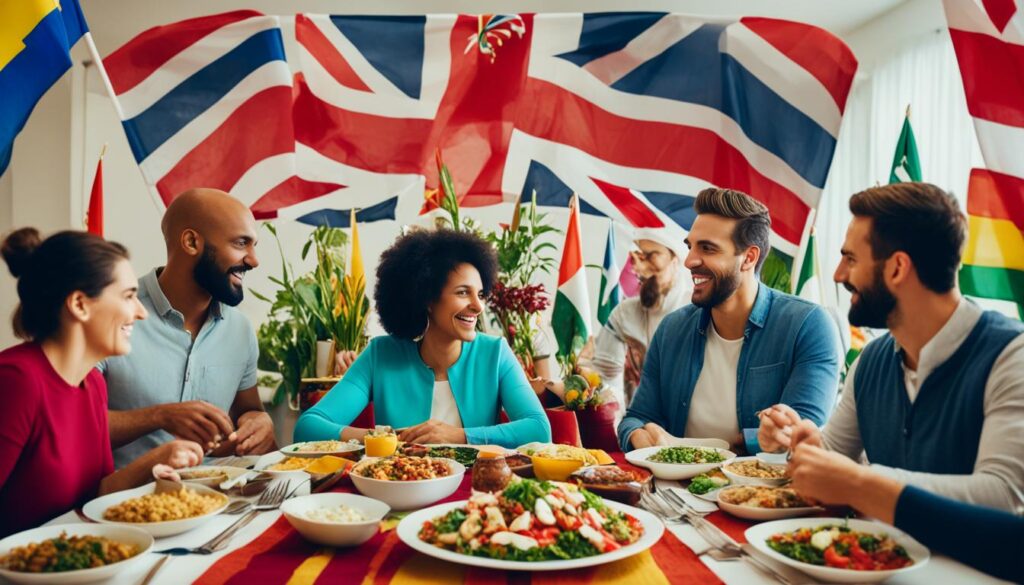As modern-day nomads, we often find ourselves in new cultural settings. We’re eager to explore and connect with people from different backgrounds. But, learning the rules of international etiquette can be tough. What if we could learn to fit in with local customs and traditions easily?
What if we could make meaningful connections with people from around the world? This guide will show you how to do just that. We’ll cover how to be culturally sensitive and communicate well across cultures. You’ll learn to appreciate diverse foods, art, and traditions.
Key Takeaways
- Develop cultural sensitivity to navigate global etiquette with ease
- Understand local customs and traditions to show respect and establish rapport
- Learn effective communication strategies to bridge cultural gaps
- Explore the richness of diverse cuisines, art, and cultural expressions
- Master cross-cultural etiquette to enhance your travel experiences
This guide is your ticket to understanding global etiquette. We’ll teach you how to be culturally sensitive and communicate well across cultures. Join us to discover the do’s and don’ts of international etiquette. Make your travels memorable and truly enriching.
Embracing Cultural Sensitivity: The Key to Successful Travel

Exploring the world’s cultures is exciting but also requires care. Cultural sensitivity is key to making the most of our trips. By learning about local customs and traditions, we show respect and connect deeply with people.
Understanding Local Customs and Traditions
Every place has its own traditions and customs. It’s important to learn about these before we go. Knowing about gestures, meal times, and sacred places helps us fit in and respect the culture.
Respecting Cultural Norms and Practices
It’s not just about knowing the customs. We must also respect the cultural norms and practices that define a community. This might mean changing how we act, dress, or talk. By doing this, we show we care and build trust with the locals.
With cultural sensitivity, we dive deep into different cultures. We make lasting friendships and learn to value the unique traditions of each place. This approach makes our travels more rewarding and life-changing.
Communication Across Cultures: Bridging the Gap

Effective cross-cultural communication is key when we travel the world. We need to learn how to connect with different cultures. This lets us engage with locals, build strong relationships, and have better interactions on our travels.
Understanding international etiquette is important. What’s seen as friendly in one place might be seen as rude elsewhere. By watching and changing how we act, we can avoid mistakes and show respect for the local ways.
Tone and how we speak also matter a lot. The way we say things can change how they’re understood. Listening well and paying attention to these details helps us talk better with others.
Knowing about common etiquette, like how to greet people or what to talk about at the dinner table, helps us connect with people from different places. Being open-minded and eager to learn makes our travels more memorable and rewarding.
As we keep exploring, learning about cross-cultural communication and international etiquette is crucial. It helps us understand each other better and make deeper connections. With these skills, our travels will be more fulfilling and life-changing.
Culture: Exploring the Richness of Diversity
Travel lets us dive into the vibrant diversity of cultures worldwide. We can enjoy local foods and appreciate art and music. This cultural richness makes our travels unforgettable.
Experiencing Local Cuisines and Flavors
Travel lets us try the local cuisines of each place. Each area has its own flavors and cooking traditions. These dishes show us the history, geography, and culture of the locals.
Trying spicy curries in India, delicate sushi in Japan, or hearty stews in Northern Europe is exciting. Each bite takes us to a new world of flavors and experiences. By trying these local cuisines, we learn about the cultural expression of each place.
Appreciating Art, Music, and Cultural Expression
Travel also lets us explore art, music, and culture. We see amazing architecture and traditional dances. Each place has its own unique cultural expression.
Visiting galleries, attending performances, or joining cultural workshops shows us human creativity. It helps us understand the diversity of human culture. This way, we learn about the traditions that shape a community.
By diving into the cultural expression and diversity of new places, we have transformative experiences. Trying the unique foods, art, and music helps us respect and connect with the world.
Navigating Cross-Cultural Etiquette: Do's and Don'ts
Traveling around the world is a great way to learn new things. But, you also need to know how to act in different places. Knowing what to wear and how to behave can really change how people see you. We’ll look at the do’s and don’ts of being polite in other cultures, from what to wear to how to use your body.
Dress Codes and Appropriate Attire
How you dress can leave a big mark. What’s okay to wear changes a lot from place to place. In some areas, you should cover up and dress modestly. In others, you can wear more casual clothes. Always check what’s usual in the places you’re going before you pack.
| Destination | Dress Code |
|---|---|
| Middle East | Conservative, with women covering their heads and avoiding short skirts or sleeveless tops. |
| Japan | Formal business attire is often the norm, especially in professional settings. |
| Brazil | Relaxed and casual, with lightweight, breathable fabrics suitable for the warm climate. |
Gestures and Body Language
How you act without words is very important. What’s okay in one place might not be in another. For instance, in some Asian countries, using your index finger to point is rude. In the U.S., it’s a common gesture. Knowing these differences helps you be more respectful and understanding.
Learning the do’s and don’ts of being polite in other cultures is key. It helps you make good connections and enjoy your travels more. By respecting the local ways, you can really dive into the culture and traditions of where you visit.
Conclusion: Embracing Global Etiquette for Enriching Travel Experiences
When we travel around the world, it’s important to be sensitive to different cultures and follow etiquette rules. This helps us have better travel experiences. By learning about local customs and communicating well across cultures, we make deeper connections. We also learn to appreciate diversity more and make memories that last a lifetime.
Exploring global cultures, trying local foods, and enjoying unique art lets us see the world in a new way. It helps us understand more about the world. Following etiquette, like knowing how to dress and use gestures, shows respect for the places we visit. This builds respect and helps us share ideas with others.
By embracing global etiquette, we can have travel experiences that change us. We learn about the world and grow personally. Being open to new cultures and willing to learn makes our travels richer. It helps us appreciate the beauty of our diverse world.

